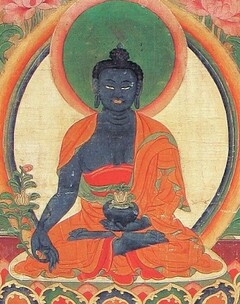Medicine Buddha Sādhana
༄༅། །སྨན་བླའི་སྒྲུབས་ཐབས་བཞུགས་སོ། །
Sādhana of Bhaiṣajya Guru (Medicine Buddha)
by Karma Chakme
བླ་མ་དཀོན་མཆོག་གསུམ་ལ་སྐྱབས་སུ་མཆི། །
lama könchok sum la kyab su chi
I take refuge in the Guru and Three Jewels.
འགྲོ་བའི་དོན་དུ་བཅོམ་ལྡན་སྨན་བླ་བསྒྲུབ། །
drowé döndu chomden men la drub
For all beings' sake, I shall accomplish the Buddha Bhaiṣajya Guru.
ཆོས་རྣམས་དམིགས་མེད་ཡེ་ནས་སྟོང་པ་ཉིད། །
chö nam mikmé yené tongpanyi
All phenomena are beyond reference, primordial emptiness.
དེ་ཡི་ངང་ལས་རང་ཉིད་དྲན་རྫོགས་སུ། །
dé yi ngang lé rangnyi dren dzok su
Out of that experience, I appear, perfect upon recollection,
དམ་ཡེ་དབྱེར་མེད་བཅོམ་ལྡན་སྨན་གྱི་བླ། །
damyé yermé chomden men gyi la
As Buddha Bhaiṣajya Guru—samaya- and jñānasattva inseparable.
སྐུ་མདོག་མཐིང་ཀ་ཞལ་གཅིག་ཕྱག་གཉིས་པ། །
kudok ting ka zhal chik chak nyipa
His body is deep blue in colour and he has one face and two hands,
ཕྱག་གཡས་མཆོག་སྦྱིན་སྨན་མཆོག་རྣམ་རྒྱལ་འཛིན། །
chak yé chok jin men chok namgyal dzin
The right hand in the supreme generosity mudrā and holding Myrobalan,
གཡོན་པས་མཉམ་བཞག་བདུད་རྩི་ལྷུང་བཟེད་བསྣམས། །
yönpé nyamzhak dütsi lhungzé nam
And the left, in the gesture of equanimity, holding an alms-bowl of nectar.
མཚན་དཔེས་རབ་བརྒྱན་རྡོ་རྗེ་སྐྱིལ་ཀྲུང་བཞུགས། །
tsenpé rab gyen dorjé kyiltrung zhuk
He is fully adorned with the signs and marks and seated in vajra posture.
སྐུ་ལ་ཆོས་གོས་རྣམ་པ་གསུམ་གྱིས་བཀླུབས། །
ku la chögö nampa sum gyi lub
And he is dressed in the three dharma robes.
པད་ཟླའི་སྟེང་བཞུགས་འོད་ཟེར་དཔག་མེད་འཕྲོ། །
pé dé teng zhuk özer pakmé tro
Seated upon lotus and moon-disc, he emanates countless rays of light.
ཐུགས་ཀར་ཟླ་སྟེང་ཧཱུྃ་ལ་སྔགས་གཡས་བསྐོར། །
tukkar da teng hung la ngak yé kor
At his heart, upon a moon, is Hūṃ surrounded clockwise by the mantra,
དེ་ལས་འོད་ཟེར་འཕྲོས་པས་ཤར་ཕྱོགས་ནས། །
dé lé özer tröpé sharchok né
From which rays of light shoot out to invite countless Bhaiṣajya Gurus
སྨན་བླ་དཔག་མེད་བྱོན་ནས་རང་ལ་ཐིམ། །
men la pakmé jön né rang la tim
Who arrive from the eastern direction and dissolve into me.
སླར་ཡང་སྐུ་ལས་འོད་ཟེར་འཕྲོས་པ་ཡིས། །
lar yang ku lé özer tröpa yi
Further rays of light then emanate from his body once again,
མཐོང་ཐོས་འགྲོ་བའི་དུག་གསུམ་ནད་ཞི་ནས། །
tong tö drowé duk sum né zhi né
To pacify sickness and the three poisons in beings who might be seen or heard,
ཐམས་ཅད་བླ་མེད་བྱང་ཆུབ་ཐོབ་གྱུར་ཅིག །
tamché lamé changchub tob gyur chik
So that they all attain unsurpassable awakening.
ཏདྱ་ཐཱ། ཨོཾ་བྷཻ་ཥ་ཛྱེ་བྷཻ་ཥ་ཛྱེ་མ་ཧཱ་བྷཻ་ཥ་ཛྱེ་རཱ་ཛ་ས་མུདྒ་ཏེ་སྭཱ་ཧཱ།
teyata om bhekanze bhekanze maha bhekanze radza samudgaté soha |
tadyathā | oṃ bhaiṣajye bhaiṣajye mahā-bhaiṣajye rāja-samudgate svāhā |
ཞེས་བསྙེན་པ་ཅི་འགྲུབ་བྱས་ནས།
Recite this mantra as many times as you can. Then:
དེ་ལྟར་སྒོམ་མཁན་ཐམས་ཅད་རང་གི་སེམས། །
detar gom khen tamché rang gi sem
The one who visualizes all this is my own mind.
སེམས་ནི་ཡོད་མེད་མཐའ་བྲལ་སྟོང་པ་ཉིད། །
sem ni yömé tadral tongpanyi
Mind itself is emptiness, beyond the extremes of existence and non-existence.
གང་ཤར་མ་ཡེངས་ཙམ་དུ་ངོ་བོ་སྐྱོངས། །
gangshar ma yeng tsam du ngowo kyong
Whatever occurs, in simple non-distraction, I will sustain the essence.
འཛིན་མེད་མ་བཅོས་ལྷུག་པར་བསྒོམ་ཤེས་ན། །
dzinmé machö lhukpar gom shé na
Knowing how to meditate freely and naturally, without clinging or contrivance,
དུག་ལྔའི་ནད་ཞི་བཅོམ་ལྡན་སྨན་བླ་འགྲུབ། །
duk ngé né zhi chomden men la drub
Pacifies the sickness of the five poisons and accomplishes Buddha Bhaiṣajya Guru.
འདི་ལྟར་སྒོམ་བཟླས་བྱས་པའི་དགེ་བ་ཡིས། །
ditar gomdé jepé gewa yi
Through the merit of visualizing and reciting mantra in this way,
མཐོང་ཐོས་དྲན་རེག་ཀུན་གྱི་ནད་ཞི་ནས། །
tong tö dren rek kün gyi né zhi né
May the sickness of all those I see, hear, think of and come into contact with be pacified,
བཅོམ་ལྡན་སྨན་བླ་ཉིད་དང་དབྱེར་མེད་ཤོག །
chomden men la nyi dang yermé shok
And may we all become inseparable from Buddha Bhaiṣajya Guru himself.
ཅེས་པ་ལྷ་རྗེ་དབང་ལུས་བསྐུལ་ནས་ལྕི་སྟོད་ཨོ་རྒྱན་གྱིས་བཞེངས་པའི་མཆོད་རྟེན་དང་ཉེ་བའི་སར། ཨ་རཱ་གས་སོ།། །།
As requested by Lharje Wanglu, this was composed by Arāga in the vicinity of the stūpa erected by Chitö Orgyen.
| Translated by Adam Pearcey, 2020.
Version: 1.1-20240513
